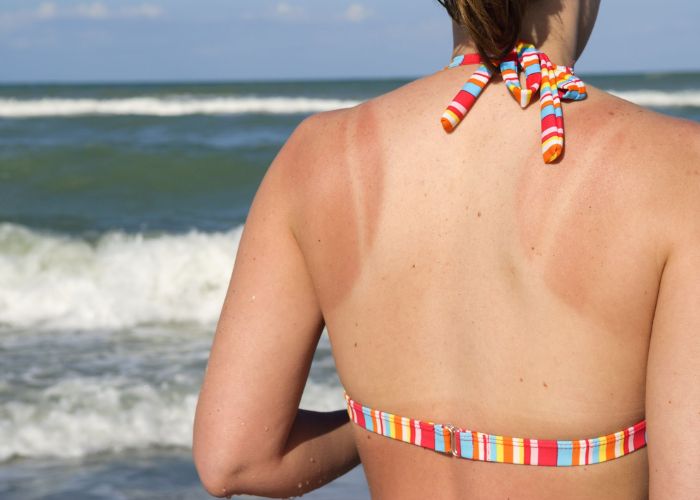The relationship between sunburns and tans has long been confusing and mysterious to a lot of people who wish to seem sun-kissed. Some individuals believe that once a sunburn fades, it becomes a tan. However, understanding the physiological principles underlying these skin reactions reveals a different reality. Let’s read below “Do Sunburns Turn Into Tans?”
Understanding Sunburns: Skin’s Response to UV Exposure
Sunburns occur when skin is overexposed to ultraviolet (UV) light, primarily from the sun. Because UV rays can penetrate the epidermis, they can harm DNA in skin cells. The body’s defensive system against this damage leads in inflammation, which gives sunburns their characteristic redness, pain, and peeling.
Do Sunburns Turn Into Tans
While it’s true that sunburns might eventually turn into tans, it doesn’t mean you shouldn’t protect yourself from the sun and limit your exposure to it.
The skin produces melanin, a pigment, in response to the sun’s ultraviolet (UV) rays. The term “sunburn” is used to describe the early stages of skin irritation and redness that can occur after extended exposure to sunlight. This is due to solar damage to the skin’s outermost layer.
Sun damage causes an increase in melanin production as skin recovers. A tan develops when the skin produces more melanin in reaction to UV radiation. Your skin’s natural defensive mechanism against UV radiation is a tan.
It’s important to remember that even while a tan may coincide with an increase in melanin and some protection from UV radiation, none of these things is guaranteed. Consistently damaging skin and raising the risk of skin cancer is long-term, excessive sun exposure. Use sunscreen, cover up with clothes, and reduce your time spent outside to prevent sun damage to your skin.
Tan Formation: Skin’s Defense Mechanism
Tannin, however, is the skin’s natural defense against UV rays. The pigment called melanin, which gives skin its color, is created by the skin in reaction to ultraviolet light. Melanin absorbs UV rays, preventing deeper skin layers from being penetrated. Through this mechanism, the body protects itself from further damage caused by continuous exposure to UV radiation.
The Myth of Sunburns Turning Into Tans
Contrary to popular belief, sunburns do not instantly turn tan. Both sunburns and tans are the skin’s response to UV light, yet they are distinct reactions with different mechanisms and outcomes.
Sunburns and Tans: Differences in Skin Response
Damage vs. Protection: Sunburns are the result of too much UV exposure, whereas tans are the result of the skin’s attempt to defend itself by producing melanin.
Severity and Depth: Sunburns damage the epidermis, whDamage vs. Protection:ich results in redness and discomfort. Tans are the result of activating melanocytes in the deeper skin, which raises melanin production without changing the appearance of the skin.
Healing Process: Sunburns vs. Tans
After becoming sunburned, the skin repairs itself to undo the harm. The underlying skin becomes more young and peels and flakes when the damaged skin cells fall off. Conversely, when the skin gradually sheds dead cells, tans often go away over a few weeks.
Safe Tanning Practices: Minimizing Risks, Maximizing Benefits
Despite the fact that many individuals would want a tan, it’s important to sparingly put skin well-being first and use sunscreen:
Sunscreen Use: Utilize an expansive range sunscreen with a high SPF to safeguard against UV radiation and decrease the gamble of sun related burn and skin harm.
Gradual Exposure: To assist your skin with tanning all the more delicately without consuming, increase your time in the sun step by step.
Protective Clothing: Wear covers, shades, and attire that covers your skin to limit direct openness to brilliant daylight.
Myth-Busting and Skin Health
It’s vital to perceive the qualifications among sun related burns and tans to support sound skincare rehearsals. The legend that sun related burns cause tanning comes from an absence of understanding about what UV beams mean for skin. Stressing reasonable sun assurance and reasonable tanning rehearsals is pivotal for keeping up with sound skin.
Seeking Professional Advice and Care
Dermatologists and other skincare experts can give master prompt on sun openness well-being, skincare regimens, and medicines for sun harm. They can offer modified exhortation in light of individual skin types and issues.
Conclusion: Clarifying Misconceptions
To summarize, sun-related burns don’t become tan. Tans and burns from the sun are two unmistakable skin responses to UV radiation; tans are a defensive response welcomed on by expanded melanin creation, while burns from the sun are a sign of skin hurt.
By monitoring these differentiations, individuals can go with informed choices in regards to sun openness and skincare that put their skin well-being before the presence of sun-related burn. I hope you like reading “Do Sunburns Turn Into Tans?”

